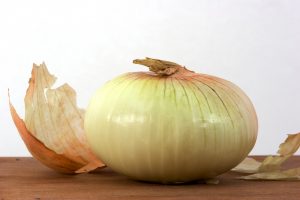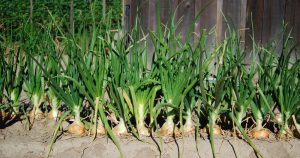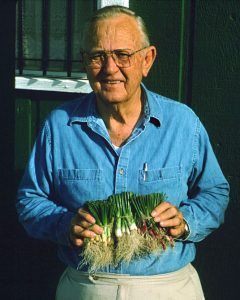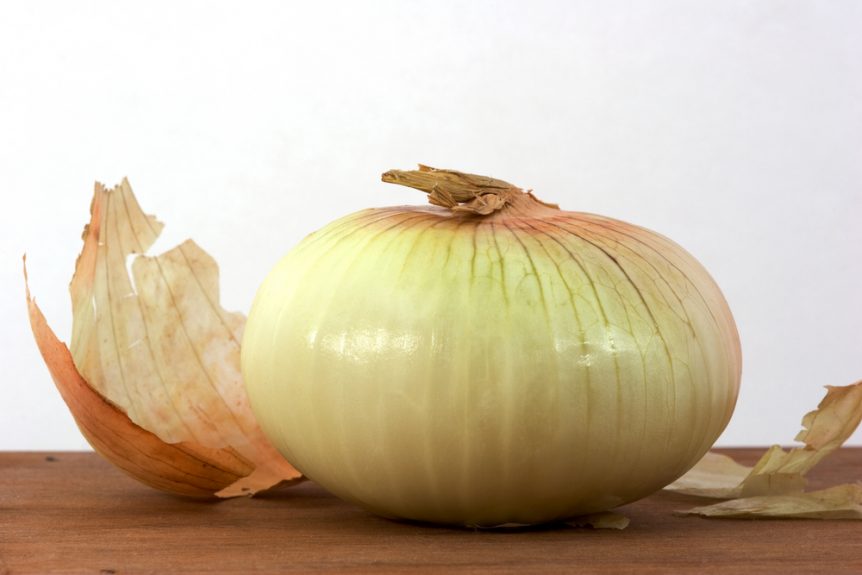
Everett Griner talks about the Vidalia onion crop and a bit of its history in today’s Agri View.
From a small geographic region of Georgia comes good news for consumers all across the nation. The Vidalia onion crop is a good one this year. Harvest is practically over now. The quality and volume are better than last year thanks to a mild winter.
You know, Vidalia is not the genetic name for that nationally acclaimed onion. It is the name of the town where the onion was first grown in Georgia.
 What makes it so popular is the mild, sweet flavor. Growers say that flavor comes from the low acid in the soil.
What makes it so popular is the mild, sweet flavor. Growers say that flavor comes from the low acid in the soil.
The original plant was called the Texas Granex. Grown in Texas naturally. Before that, it was simply a Mexican onion.
The volume of the crop has not been reported yet. But, we know it is bigger and better than last year’s crop.
That’s Agri View for today. I’m Everett Griner…
From: Texas A&M Agrilife Extension
Onion Transplants from Texas Play a Major Role in the Beginning of the Vidalia Onion – 1952
 Texas-bred Granex has been popularized worldwide under many different names. One such onion is the Vidalia. Vidalias were first grown in Toombs County, Georgia when a farmer named Mose Coleman discovered that the onions he had planted were not hot, as expected. They were sweet! The first Granex onions grown in the Vidalia, Georgia area were grown from transplants. The reason behind this was because at first herbicides were not available to control weeds and the weeds would grow faster than the onions.
Texas-bred Granex has been popularized worldwide under many different names. One such onion is the Vidalia. Vidalias were first grown in Toombs County, Georgia when a farmer named Mose Coleman discovered that the onions he had planted were not hot, as expected. They were sweet! The first Granex onions grown in the Vidalia, Georgia area were grown from transplants. The reason behind this was because at first herbicides were not available to control weeds and the weeds would grow faster than the onions.
“In 1952 Granex transplants from Dixondale Farms (Carrizo Springs, Texas) were first shipped to Georgia,” said Wallace Martin, President of Dixondale Farms. Yellow Bermuda transplants were shipped in the ’40’s. The greatest quantity of Granex transplants shipped to Georgia by Dixondale Farms was 17 18,000 crates in 1981. Early Jordan of Griffin & Brand took the first truckload of transplants (Yellow Bermuda) from Earl McClenson to Vidalia in 1944. Before that several crates

Wallace
were shipped by Rail Express. The Granex Y-33 (Asgrow Seed Company) was the most commonly produced transplant.
It was a struggle to sell the onions at first, but Coleman persevered and managed to sell them for $3.50 per 50-pound bag, which in those days was a big price. Other farmers, who through the Depression years hadn’t been able to get a fair price for their produce, thought Coleman had found a gold mine! They began to follow suit, and soon after, their farms were also producing the sweet, mild onion.
The State of Georgia built a Farmers’ Market in Vidalia, and because the small town was at the juncture of some of South Georgia’s most widely traveled highways, the market had a thriving tourist business. Word began to spread about “those Vidalia onions.” Consumers, then, gave the onions their famous name. Vidalia Onions have developed an international reputation as the “world’s sweetest onion.” Their mild flavor is claimed to be due to the unique combination of soils and climate found in the 20-county production area.
“Vidalia onions” began appearing on the shelves of Piggly Wiggly and A&P grocery stores. Through the 1950s and 60s, production grew at a slow but steady pace, reaching some 600 total acres by the mid-1970s. At this point, a push was made for Vidalia onions to be distributed throughout the nation, and several promotional efforts were begun. Onion festivals became an annual event in both Vidalia and nearby Glennville, Georgia, and production grew tenfold over the next decade.
 Approximately 225 growers cultivate Vidalia onions on over 14,000 acres. About 125 handlers are involved in the grading, packing, and distribution of Vidalias. An average of 300 50-pound bags of Vidalias is produced per acre. Approximately 6% of the 275 growers cultivate 100 acres or more; 7% produce on 50 to 100 acres; 40% on 10 to 15 acres; and 47 % on 10 or fewer acres. The majority of Vidalia onion farms are multi-generational, family-owned-and-operated businesses.
Approximately 225 growers cultivate Vidalia onions on over 14,000 acres. About 125 handlers are involved in the grading, packing, and distribution of Vidalias. An average of 300 50-pound bags of Vidalias is produced per acre. Approximately 6% of the 275 growers cultivate 100 acres or more; 7% produce on 50 to 100 acres; 40% on 10 to 15 acres; and 47 % on 10 or fewer acres. The majority of Vidalia onion farms are multi-generational, family-owned-and-operated businesses.
The industry’s annual Vidalia onion harvest brings some $50 million directly into Georgia’s economy. The economic impact from related downstream marketing activities is estimated at $145- $150 million.
Vidalia onions are sold loose by the pound, in 2-, 3- and 5-pound “pre-packs,” and in 10-, 25- and 50-pound mesh bags and boxes. Generally recognized Vidalia onion sizes are small (1 to 2 1/4 inches), medium (2 to 3 inches), and jumbo (over 3 inches).
Obviously, the Texas-bred Granex has been popularized worldwide under many different names and produced tremendous economic advantages wherever it is used.










